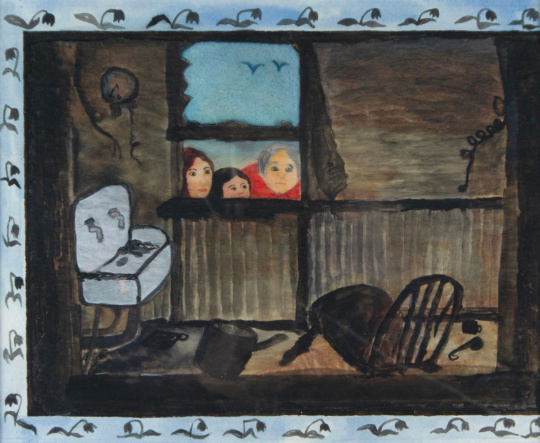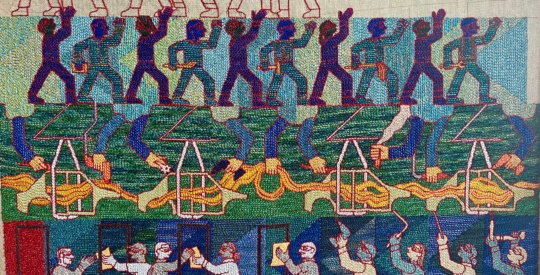
“Nymphs and Shepherds Come Away: Ten Women Artists Respond to Secular Themes from the Renaissance,” on view at {Poem 88} through February 13, is anything but a lighthearted encomium to love and flowers. After all, Botticelli’s Primavera, often presented to artists as a source of inspiration, is such a difficult work of symbolism that art historians once considered it a mystical Neoplatonic allegory. Today, however, the only consensus about it is that it combines unusual attention to literal detail (hundreds of species of flowers accurately rendered) with mythic images of Venus and Cupid, the Three Graces, Zephyrus and Flora, and Mercury that clearly have more than a literal meaning.
By contrast, the show’s other inspirational work, Henry Purcell’s song “Nymphs and Shepherds,” reflects a time two centuries later in which the mythic tropes had degenerated into a metaphoric shorthand not to be taken seriously. This is more akin to the empty clichés they are frequently thought to be today, when they are remembered at all.

“When they are remembered at all” is the key for several artists in the show. Sharon Shapiro’s two watercolors Strange Magic and Dreamweaver reduce the Renaissance allegory of love to sleazy contemporaneity mingled with small aspects of subtly mythic fantasy. InKyoung Chun’s oil on canvas depicts a mug (for mom) bearing the words “Queen of Everything” and a decorative border vaguely resembling leaves. Carol John’s Renaissance Woman is an enigmatic archival print and acrylic on paper that overlays a 1950s illustration of a woman’s hairstyle with two circular forms that can be interpreted as anything from googly-eyes to two fried eggs. Nancy VanDevender’s pigment ink on paper Come Away With Me features the words of the title intermingled with spiky or fluidly abstracted floral imagery.
VanDevender’s incorporation of barely recognizable floral motifs stands in interesting contrast to the more literal but still gestural flowers in Zuzka Vaclavik’s mixed media on paper, Bouquet for Artemisia Gentileschi — a curious art-historical homage as no surviving works by the 17th-century painter have flowers as a major feature; most present dark Biblical tales of female violation and revenge. The show’s other flower paintings, Hannah Tarr’s Another Day, More Pond and Nu Venus, replace the goddess of love with floral symbols of transience and eroticism.

Tarr incorporates the classical inheritance obliquely, but the show’s remaining four artists confront the problematic meaning of antique allegory head on. Judy Henson incorporates the Three Graces into contemporary digital collage in the freeform dye sublimation print on aluminum Veil for Three Graces, a work so overwhelmingly handsome that viewers are likely to forget the question of meaning entirely. Cynthia Farnell’s pigment inkjet prints on paper mingle Greco-Roman statuary with contemporary symbols of the myths of Narcissus, Diana and Actaeon, and Daphne, and Renaissance allegory is replaced with latter-day visual metaphor, as when Narcissus is represented by a mirror overlaid with narcissus flowers.

The works of Faith McClure and Julia Kjelgaard approach the difficult issue of relating Renaissance appropriation of ancient mythology to contemporary ignorance of myth. This makes their works the toughest to interpret. Viewers could profitably spend hours pondering the powerful mix of ancient and contemporary figures in McClure’s three mixed media on Mylar works the chaste flapping their wings, gravity pulsing half maroon, and blood like pomegranate, life suddenly opens. Kjelgaard’s potent combination of antique prints and present-day photographs of clouds and trees in Acadia and Long Sky likewise calls for extended interpretation that demands knowledge of the visual sources, unless we let the formal pleasures of the compositions satisfy us and let it go at that, just as in contemporary encounters with Botticelli’s Primavera, “Nymphs and Shepherds Come Away” goes far in prompting thought about our troubled relationship to a Renaissance inheritance that once was taken for granted as the bedrock of modern artistic practice — “modern” as of the 19th century. What it all means in the age of digital reproduction is worthy of being rethought, and the different chronological ages and cultural backgrounds of the artists invited to produce work for this exhibition provide an instructive matrix within which to do that rethinking.
On the other hand, one could just look at the show as offering, as the gallery’s promotional e-mail says, “something for everyone.”
Dr. Jerry Cullum is a freelance curator and critic living in Atlanta. His poems, reviews, and essays have appeared in a wide variety of local and national publications, including Art Papers and Art in America.




